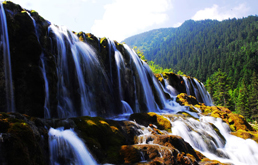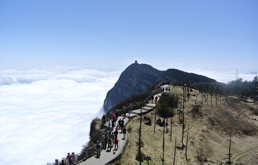Chengdu
Pandas' Hometown
Jiuzhaigou
Famous Fairyland
Emeishan
Sacred Buddhist Site
Leshan
Giant Buddha
Gonggashan
Best for Hiking
Daocheng Yading
Shangri La Views
Dujiangyan
Irrigation System
Siguniangshan
Eastern Alps
Temple is the treasure house of Chinese art especially Buddhist culture. It is also a complete preservation of the historical relics of past dynasties in China. The combination of temple architecture and traditional palace architecture has distinct national style and folk characteristics. At the same time, temple culture has penetrated into all aspects of our life, such as astronomy, geography, architecture, painting, calligraphy, sculpture, music, dance, cultural relics, temple fair, folk customs and so on. The annual temple fair is in full swing, which not only enriches the cultural atmosphere, but also promotes the development of local tourism. Here are most featured temples you are recommended to visit:
Types: Religious Site
Visit: 1~2 hours
Zhaojue Monastery is an influential Buddhist temple which has alredy existed for more than 1480 years. It is located about 5 kilometers away northeast from central Chengdu city, close the Chengdu Zoo. Its longlansting history can be dated back to Han Dynasty when a official named Dong Chang residence here, and gave the original name of Jianyuan. It became a Buddhist monastery during 627~649 of Tang Dynasty. Later, Xi Zong of Tang gave it the name “Zhaojue” which is still currently used. Zhaojue refers a deep theory in Buddhism – Revelation and Enlightenment which simply means “”instructing the people with perfect understanding of Dharma and enlightening the later starters in Dharma learning.” ...
Types: Religious Site
Visit: 1~2 hours
Qingyang Taoist Temple is a Quanzhen School Taoist Temple and an important national Quanzhen Taoist Temple in China. It is located on the west by the first ring road in Chengdu. It is also named the Number 1 Taoist Temple in Chengdu. Qingyang Taoist Temple also has a very long history. It was built in Zhou Dynasty which is about 3000 years ago. It was rebuilt in Dynasty by Emperor Xizong. But it was destroyed by the end of Ming Dynasty. The constructions left today are mainly from Qing Dynasty by Emperor Kangxi. The temple is composed of Entrance Screen, Three Saints Hall, Emperor Tang’s Hall, Huangyuan Hall and Taichi Pagoda. Taichi Pagoda is the most luxury construction with a well-decorated Lao Tzu Statue. The most precious Taoist book is stored in this temp as well...
Types: Religious Site
Visit: 2 hours
Baoguang Monastery is believed to be built in Eastern Han Dynasty about 1900 years ago. It is one of the four greatest monasteries within the Yangtze River Range. It is located 20km north to Chengdu. Baoguang Monastery is a big Buddhist Monastery with a complete system with different constructions. It is only about half an hour’s drive from Chengdu one shall reach Baoguang Monastery in Xindu District in the north. It covers a total of 8 hectares inside the condense area of Xindu. Entrance charge is 5 yuan...
Types: Museum
Visit: 2-3 hours
Wuhou Shrine is also called Han Zhaolie Temple, or Memorial of Zhugeliang. It is a temple in memory of the famous Chinese Prime Minister from Three Kingdoms about 18 centuries ago. It was built in 223 AD when people started to build a tomb for Liu Bei, the king of Shu. Wuhou Shrine is the only one temple in China that has a king and a minister in a temple together. In China, three kingdoms are popular historical facts. There is three kingdoms culture. And Wuhou Shrine is one the most significant sites of this culture. Wuhou is the prime minister. And the name of the temple was after the prime minister instead of the king.
Types: Monastery
Visit: 2-3 hours
Wenshu Monastery is located at Wenshufang, a traditional street block in the city of Chengdu. It is one of the most important Chinese Buddhist Monasteries in China. Wenshu Monastery is also the head of the four great monasteries at upper/middle Yangtze Range. It is a monastery, a Zen shrine, a traditional garden and a pilgrimage destination. It was first built in Sui Dynasty in the beginning of the 7th Century and rebuilt during Kangxi Area in the 17th Century. This monastery has a size of 200,000 sqm and all built in wood. It has in total 300 statues in the monastery. It was called Xinxiang Temple at the beginning and later changed into Miaoyuan Buddha Stupa.

Route: Chengdu - Dujiangyan - Chengdu

Route: Chengdu - Jiuzhaigou

Route: Chengdu - Leshan - Emeishan - Chengdu